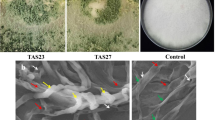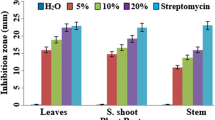Abstract
Azotobacter chroococcum TRA2, an isolate of wheat rhizosphere displayed plant growth promoting attributes including indole acetic acid, HCN, siderophore production, solubilization of inorganic phosphate and fixation of atmospheric nitrogen. In addition, it showed strong antagonistic effect against Macrophomina phaseolina and Fusarium oxysporum. It also caused degradation and digestion of cell wall components, resulting in hyphal perforations, empty cell (halo) formation, shrinking and lysis of fungal mycelia along with significant degeneration of conidia. Fertilizer adaptive variant strain of A. chroococcum TRA2 was studied with Tn5 induced streptomycin resistant transconjugants of wild type tetracycline-resistant TRA2 (designated TRA2tetra+strep+) after different durations. The strain was significantly competent in rhizosphere, as its population increased by 15.29 % in rhizosphere of Sesamum indicum. Seed bacterization with the strain TRA2 resulted in significant increase in vegetative growth parameters and yield of sesame over the non-bacterized seeds. However, application of TRA2 with half dose of fertilizers showed sesame yield almost similar to that obtained by full dose treatment. Moreover, the oil yield increased by 24.20 %, while protein yield increased by 35.92 % in treatment receiving half dose of fertilizer along with TRA2 bacterized seeds, as compared to untreated control.


Similar content being viewed by others
References
Adesemoye AO, Torbert HA, Kloepper JW (2009) Plant growth promoting rhizobacteria allow reduced application rates of chemical fertilizers. Microb Ecol 58:921–929
Aeron A, Kumar S, Pandey P, Maheshwari DK (2011) Emerging role of plant growth promoting rhizobacteria in agrobiology. In: Maheshwari DK (ed) Bacteria in agrobiol: crop ecosystems. Springer, Heidelberg, pp 1–36
Altschul SF, Gish W, Miller W, Meyers EW, Lipman DJ (1990) Basic local alignment search tool. J Mol Biol 215:403–410
Ayala S, Rao EVSP (2002) Perspective of soil fertility management with a focus on fertilizer use for crop productivity. Curr Sci 82:797–807
Bedigian T (1985) Sesamin, sesamoline and the original of sesame biochem systematics. Ecol 13:9–133
Bhatnagar A, Gupta A (1998) Chlorpyriphos, quinalphos, and lindane residues in sesame (Sesamum indicum L.) seed and oil. Bull Envi Contam Toxicol 60:569–600
Bradford MM (1976) A rapid and sensitive method for the quantitation of microorganism quantities of protein utilizing the principle of protein in dye binding. Anal Biochem 72:248–254
Dubey RC, Maheshwari DK (2011) Role of PGPR in integrated nutrient management of oil seed crops. In: Maheshwari DK (ed) Bacteria in agrobiology: plant nutrient management. Springer, Heidelberg, pp 1–14.
Dubey RC, Maheshwari DK, Kumar V, Pandey RR (2012) Growth enhancement of Sesamum indicum L. by rhizosphere-competent Azotobacter chroococcum AZO2 and its antagonistic activity against Macrophomina phaseolina. Arch Phytopathol Plant Protect 45(4): 437–454
Duhoon SS, Jyoteishi A, Deshmukh MR, Singh NB (2004) Optimization of Sesamum indicum production through bio-natural inputs. In: 4th international crop science congress, The Regional Institute, Sydney
Dunne C, Crowely JJ, Moenne-Loccoz Y, Dowling DN, de Brujin FJ, O’Gara F (1997) Biological control of Pythium ultimum by Stenotrophomonas maltophislia W81 is mediated by an extracellular proteolytic activity. Microbiol 143:3921–3931
El-Bramawy MASA, Wahid OA (2009) Evaluation of resistance of selected sesame (Sesamum indicum) genotypes to Fusarium wilt disease caused by Fusarium oxysporum f. sp. sesami. Tunis J Plant Prot 4:29–39
Garrity G (2005) The proteobacteria, Part B the gammaproteobacteria. In: Brenner DJ, Krieg NR, Staley JT (eds), Bergey’s manual of systematic bacteriology, 2nd edn, vol 2. Springer, New York, NY, pp 323–379
Glick BR (1995) The enhancement of plant growth by free-living bacteria. Can J Microbiol 47:109–117
Gomez AK, Gomez AA (1984) Statistical procedure for agricultural research. Wiely, New York, pp 208–215
Gricher WJ, Sestak DC, Brewer KD, Besler BA, Stichler RC, Smith DT (2001) Sesame (Sesamum indicum) tolerance and weed control with soil-applied herbicdes. Crop Prot 20(5):389–394
Gupta CP, Sharma A, Dubey RC, Maheshwari DK (1999) Pseudomonas aeruginosa as a strong antagonist of Macrophomina phaseolina and Fusarium oxysporum. Cytobios 99:183–189
Habbasha SF, Salam MS, Kabesh MO (2007) Response of two sesame varieties (Sesamum indicum L.) to partial replacement of chemical fertilizers by bio-organic fertilizers. Res J Agri Biol Sci 3(6): 563–571
Joshi KK, Kumar V, Dubey RC, Maheshwari DK (2006) Effect of chemical fertilizer adaptive variants, Pseudomonas aeruginosa GRC2 and Azotobacter chroococcum AC1 on Macrophomena phaseolina causing charcoal rot of Brassica juncea. Korean J Environ Agric 25:228–235
Kartha ARS, Sethi AS (1957) A cold percolation method for rapid gravimetric estimation of oil in small quantities of oilseeds. Ind J Agric Sci 27:211–217
Kesavan PC, Swaminathan MS (2006) From green revolution to evergreen revolution: pathways and terminologies. Curr Sci 91:145–146
Khare E, Arora NK (2010) Effect of indole-3-acetic acid (IAA) produced by Pseudomonas aeruginosa in suppression of charcoal rot disease of chickpea. Curr Microbiol 61(1):64–68
Kumar A, Vij N, Randhawa GS (2003) Isolation and symbiotic characterization of transoposon Tn-5 induced arginine auxotrophs of Sinorhizobium meliloti. Ind J Exp Biol 41:1198–1204
Kumar B, Dubey RC, Maheshwari DK (2005) Biocontrol of Macrophomina phaseolina: prospects and constraints. In: Satyanarayana T, Johri BN (eds) Microbial diversity: current perspectives and potential applications. IK International Pvt Ltd, New Delhi, pp 471–492
Kumar P, Tripathi N, Verma O (2006) Biofertilizers: a boon for agriculture. Agric Update 1(3):45–47
Kumar S, Pandey P, Maheshwari DK (2009) Reduction in dose of chemical fertilizers and growth enhancement of sesame (Sesamum indicum L.) with application of rhizospheric competent Pseudomonas aeruginosa LES4. Eur J Soil Biol 45:334–340
Kumar S, Aeron A, Pandey P, Maheshwari DK (2011) Ecofriendly management of charcoal rot and Fusarium wilt diseases in Sesame (Sesamum indicum L.). In: Maheshwari DK (ed) Bacteria in agrobiology: crop ecosystems. Spriger, Heidelberg, pp 387–405
Lanje PW, Buldeo AN, Zade SR, Gulhane VG (2005) The effect of Rhizobium and phosphorous solubilizers on nodulation, dry matter, seed protein, oil and yield of soybean. J Oilseeds Res 15:132–135
Lim HS, Kim SD (1995) The role and characterization of β-1,3-glucanase in biocontrol of Fusarium solani by Pseudomonas stutzeri YLP1. Curr Microbiol 33:295–301
Maheshwari DK, Kumar S, Maheshwari NK, Patel D, Saraf M (2012) Nutrient availability and management in the rhizosphere by microorganisms. In: Maheshwari DK (ed) Bacteria in agrobiology: stress management. Springer, Heidelberg, pp 301–326
Maidak BL, Cole JR, Lilburn TG, Parker CT, Saxman PR, Stredwick JM, Garrity GM, Li B, Olsen GJ, Pramanik S, Schmidt TM, Tiedje JM (2000) The RDP (ribosomal database project) continues. Nucleic Acids Res 28:173–174
Miller RL, Higgins BB (1970) Association of cyanide with infection of birds foot trefoil by Stemphylium loti. Phytopathol 60:104–110
Miyahara Y, Hibasami H, Katsuzaki H, Komiya Imai K (2001) Sesamolin from sesame seed inhibits proliferation by inducing apoptosis in human lymphoid leukemia Molt 4B cells. Int J Mol Med 7:369–371
Pandey P, Kang SC, Gupta CP, Maheshwari DK (2005) Rhizosphere competent Pseudomonas aeruginosa GRC1 produces characteristic siderophore and enhance growth of Indian mustard (Brassica campestris). Curr Microbiol 51:303–309
Poul KI, Savithri KE (2003) Effect of biofertilizers vs. perfected chemical fertilization for sesame grown in summer rice fallow. J Trop Agri 41:47–49
Salimath PM, Bahl PN (1986) Association analysis and plant ideotype in chick pea (Cicer arietinum L.). Expt Gen 2:41–46
Sankar D, Sambandam MR, Rao PKV (2004) Impact of sesame oil on nifedipine in modulating oxidative stress and electrolytes in hypertensive patients. Asia Pac J Clin Nutr 13:107
Schwyn B, Neilands JB (1987) Universal assay for the detection and determination of siderophores. Anal Biochem 160:47–56
Selvaraj G, Iyer VN (1983) Suicide plasmid vehicles for insertion mutagenesis in Rhizobium meliloti and related bacteria. J Bacteriol, 156(3):1292
Singh RP, Chandel SKS, Yadav PK, Singh SN (2011) Effect of Ni on Nitrogen uptake and yield of wheat. Ind J Sci Res 2(4):61–63
Skujins JJ, Potgieter HJ, Alexander MA (1965) Dissolution of fungal cell wall by a Streptomyces chitinase and β-1, 3-glucanase. Arch Biochem Biophys 111:358–364
Subba-Rao NS (1982) Advances in agricultural microbiology. In: Subba-Rao NS (ed) Studies in the agriculture and food sciences. Butterworth Scientific, London, pp 295–303
Van Loon LC (2007) Plant responses to plant growth-promoting Rhizobacteria. Eur J Plant Pathol 119:243–254
Vargas MAT, Mandes IC, Hungaria M (2000) Response of field-grown bean (Phaseolus vulgaris L) to Rhizobium inoculation and nitrogen fertilization in two carrados soils. Biol Fert Soil 33:228–233
Wani PV, Patil LK (1979) Phosphorous solubilizing activity of microorganism using two P-carriers. Nat Acad Sci Lett 2(10):360–362
Weidenborner M, Uziel M, Hamacher J, Hindorf H, Weltzien HC (1989) A preparation method of Aspergillus spp for scanning electron microscopy. J Phytopathol 126:1–6
Weller DM, Cook RJ (1983) Suppression of take all the wheat by seed treatment with fluorescent pseudomonads. Phytopathology 23:23–54
Wu SC, Cao ZH, Li ZG, Cheung KC, Wong MH (2005) Effects of biofertilizer containing N-fixer, P and K solubilizers and AM fungi on maize growth: a greenhouse trial. Geoderm 125:155–166
Acknowledgments
The authors wish to thank the TMOP & M, CSIR (New Delhi), UGC (New Delhi), UCOST (Dehradun) and CST (UP) India for financial assistance.
Author information
Authors and Affiliations
Corresponding author
Rights and permissions
About this article
Cite this article
Maheshwari, D.K., Dubey, R.C., Aeron, A. et al. Integrated approach for disease management and growth enhancement of Sesamum indicum L. utilizing Azotobacter chroococcum TRA2 and chemical fertilizer. World J Microbiol Biotechnol 28, 3015–3024 (2012). https://doi.org/10.1007/s11274-012-1112-4
Received:
Accepted:
Published:
Issue Date:
DOI: https://doi.org/10.1007/s11274-012-1112-4




